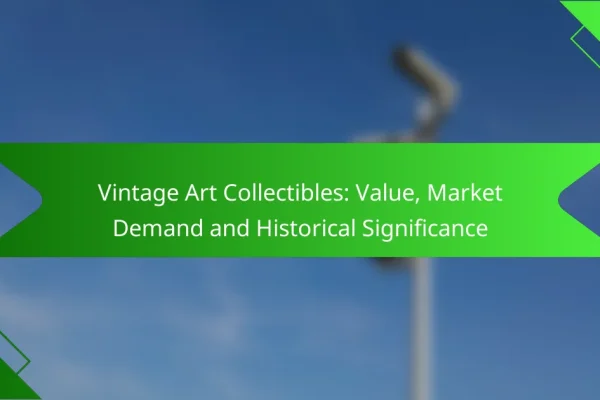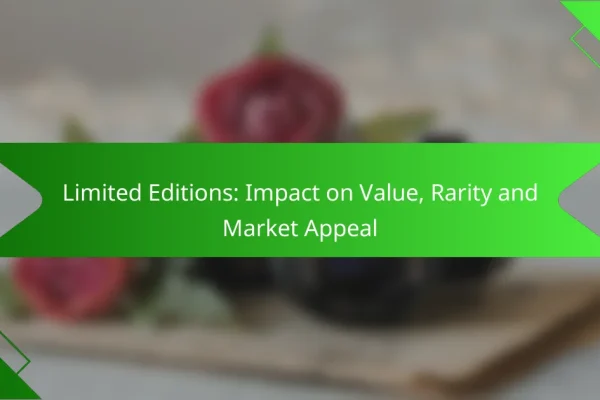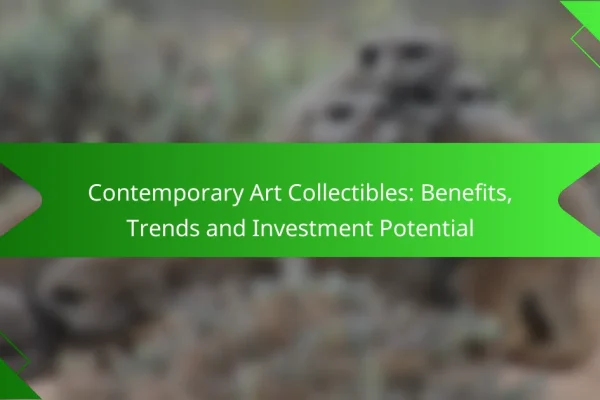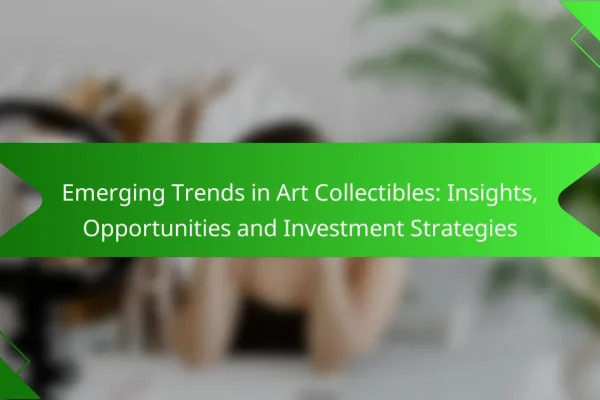What are the most popular types of art collectibles?
The most popular types of art collectibles include paintings, sculptures, photography, prints, and mixed media. Each category offers unique characteristics and investment potential, appealing to various tastes and budgets.
Paintings
Paintings are often considered the cornerstone of art collectibles, ranging from classical masterpieces to contemporary works. When investing in paintings, consider the artist’s reputation, the artwork’s provenance, and its condition. Prices can vary significantly, from a few hundred dollars for emerging artists to millions for established names.
Collectors should focus on factors such as style, medium, and historical significance. Works by renowned artists often appreciate over time, making them a popular choice for both aesthetic enjoyment and investment.
Sculptures
Sculptures are three-dimensional artworks that can be made from various materials, including bronze, marble, and wood. They can range from small tabletop pieces to large outdoor installations. When collecting sculptures, pay attention to the artist’s technique and the piece’s size, as these factors can greatly influence value.
Consider the sculpture’s placement and how it complements your existing collection or space. Limited editions or works by well-known sculptors tend to hold their value better, making them a smart investment.
Photography
Photography as an art form has gained immense popularity, with both vintage and contemporary works attracting collectors. Limited edition prints from established photographers can be particularly valuable. When collecting photography, look for pieces that resonate with you personally while also considering the artist’s reputation and the print’s rarity.
Condition is crucial in photography; ensure that prints are properly stored and displayed to maintain their quality. Emerging photographers can also be a worthwhile investment, as their work may appreciate as they gain recognition.
Prints
Prints are reproductions of original artworks, often created using techniques like lithography, screen printing, or etching. They can be more affordable than original pieces, making them accessible to a broader audience. When collecting prints, check for the edition size and the artist’s signature, as these factors can affect value.
Look for prints that are part of a limited series, as these are typically more sought after. Understanding the printing technique can also help you appreciate the work’s uniqueness and quality.
Mixed media
Mixed media art combines various materials and techniques, creating unique and often textured pieces. This category allows artists to experiment and push boundaries, resulting in innovative works. When collecting mixed media, consider how the different elements interact and the overall aesthetic appeal.
Due to their diverse nature, mixed media pieces can vary widely in price. Pay attention to the artist’s vision and the materials used, as these can significantly impact both the artwork’s value and your enjoyment of it.
How to start an art collectibles collection?
Starting an art collectibles collection involves careful planning and a clear understanding of your interests and budget. Begin by defining how much you are willing to spend and what types of art appeal to you.
Define your budget
Establishing a budget is crucial for any art collectibles collection. Determine a comfortable spending range that includes not only the purchase price but also potential costs for framing, insurance, and maintenance.
Consider setting a maximum limit for individual pieces, which can help you avoid impulse buys. For beginners, a budget of a few hundred to a few thousand dollars can be a good starting point.
Research art styles
Understanding different art styles is essential for building a meaningful collection. Explore various genres such as contemporary, classical, or abstract art to identify what resonates with you.
Utilize online resources, books, and art magazines to deepen your knowledge. Attending workshops or lectures can also provide valuable insights into the art world and help refine your preferences.
Visit galleries and auctions
Visiting galleries and auctions allows you to experience art firsthand and gain a better understanding of market values. Take the time to explore local galleries, art fairs, and auction houses to see a variety of works.
Engage with gallery owners and artists to learn more about their pieces and the stories behind them. Attending auctions can also provide insight into pricing trends and bidding strategies, which are valuable for future purchases.
What factors influence the value of art collectibles?
The value of art collectibles is influenced by several key factors, including the artist’s reputation, the artwork’s provenance, its condition, and current market demand. Understanding these elements can help collectors make informed decisions when buying or selling art.
Artist reputation
The reputation of the artist plays a significant role in determining the value of their work. Established artists with a strong track record often command higher prices, while emerging artists may offer more affordable options but with potential for appreciation. Collectors should research an artist’s background, exhibitions, and auction results to gauge their standing in the art world.
For instance, works by renowned artists like Pablo Picasso or Vincent van Gogh typically sell for millions, while lesser-known artists might range from hundreds to thousands of dollars. Investing in art from artists with growing recognition can be a strategic move.
Provenance
Provenance refers to the history of ownership of an artwork, which can greatly impact its value. A clear and documented provenance can enhance an artwork’s desirability, while a lack of documentation may raise concerns about authenticity. Collectors should seek artworks with well-established provenance to ensure their investment is secure.
For example, if an artwork has been part of a prestigious collection or exhibited in major galleries, it is likely to be valued higher. Always request provenance information when considering a purchase, as it can be a crucial factor in future resale value.
Condition
The physical condition of an artwork is essential in assessing its value. Artworks that are well-preserved and free from damage typically command higher prices. Collectors should carefully examine pieces for signs of wear, restoration, or damage before making a purchase.
For instance, a painting with minor scratches may still be valuable, but one with significant damage could see its value drop by a substantial percentage. Consider hiring a professional conservator for a thorough evaluation if you are unsure about an artwork’s condition.
Market demand
Market demand significantly influences the value of art collectibles. Trends in the art market can shift rapidly, affecting the desirability of certain styles, periods, or artists. Staying informed about current market trends can help collectors make timely decisions.
For example, contemporary art has seen a surge in popularity, leading to increased prices for works by living artists. Monitoring auction results and gallery exhibitions can provide insights into what is currently in demand, helping collectors identify potential investment opportunities.
Where to buy art collectibles in major cities?
Art collectibles can be purchased in various venues across major cities, including art fairs, online marketplaces, and local galleries. Each option offers unique benefits and considerations, making it essential to understand where to find the best pieces for your collection.
Art fairs
Art fairs are large events where multiple galleries and artists showcase their work, providing a vibrant atmosphere for collectors. These fairs often feature a wide range of styles and price points, allowing you to discover new artists and trends.
When attending an art fair, consider setting a budget and researching participating galleries beforehand. This preparation can help you navigate the event more effectively and make informed purchasing decisions.
Online marketplaces
Online marketplaces have become increasingly popular for buying art collectibles, offering convenience and a vast selection. Websites like Artsy, Saatchi Art, and Etsy allow collectors to browse and purchase art from the comfort of their homes.
While shopping online, pay attention to seller ratings and return policies. It’s also wise to verify the authenticity of the artwork and consider shipping costs, which can vary significantly based on the seller’s location and the item’s size.
Local galleries
Local galleries provide a more personal experience for art collectors, often featuring works from regional artists. Visiting these galleries allows you to engage with gallery owners and artists, gaining insights into the pieces and their backgrounds.
When exploring local galleries, don’t hesitate to ask questions about the artwork and the artists. Many galleries also host events and exhibitions, providing opportunities to meet other collectors and expand your network in the art community.
What are the risks of investing in art collectibles?
Investing in art collectibles carries several risks that potential buyers should consider. These include market volatility, authenticity issues, and ongoing costs related to storage and insurance.
Market volatility
The art market can experience significant fluctuations, which may affect the value of collectibles. Prices can rise and fall based on trends, economic conditions, and collector demand. For example, contemporary art may see rapid appreciation during a market boom but can also decline sharply during downturns.
Investors should be prepared for these changes and consider diversifying their portfolios to mitigate risks. Keeping an eye on market trends and auction results can help gauge potential value shifts.
Authenticity issues
Authenticity is a critical concern when investing in art collectibles, as the presence of forgeries can undermine value. Buyers must ensure that they are purchasing genuine pieces, often requiring provenance documentation or expert appraisals. Without proper verification, an investment can quickly lose its worth.
To reduce the risk of acquiring counterfeit art, consider purchasing from reputable galleries or auction houses that provide guarantees of authenticity. Engaging with art advisors or appraisers can also offer additional layers of protection.
Storage and insurance costs
Investing in art collectibles involves ongoing costs, including storage and insurance. Proper storage is essential to maintain the condition and value of the artwork, which may require climate-controlled environments. These facilities can be costly, particularly for high-value pieces.
Insurance is another necessary expense, as it protects against theft, damage, or loss. Premiums can vary widely based on the artwork’s value and the coverage terms. It’s advisable to regularly assess both storage and insurance needs to ensure adequate protection for your investment.












